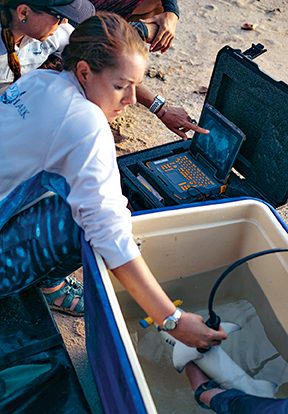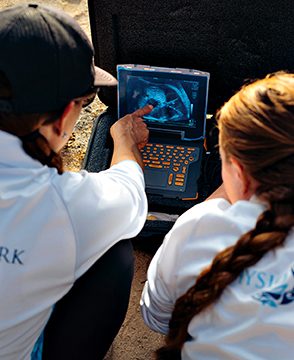
FOR 450 MILLION YEARS some shark species have been apex predators in the aquatic world, helping to balance the fathomless yet fragile marine ecosystem. These evolutionary masterpieces have survived mass extinction events, but even with all their instinctual knowledge we see more and more species on our endangered lists.
They face many new and changing threats, from longline fishing and abandoned nets to habitat encroachment and fish stock depletion. An even more damaging force is now spreading through the world’s oceans, one that threatens all life on this planet: climate change.
It is up to ocean lovers and advocates to help protect sharks today to ensure there will be sharks tomorrow and for future generations. At the Center for Island Research and Environmental Observatory (CRIOBE) Research Center on Moʻorea, French Polynesia, Jodie Rummer, PhD, of James Cook University in Queensland, Australia, investigates how climate change affects the physiology of newborn and juvenile reef sharks. Since 2013 the Physioshark project has investigated the physiological energetics of newborn blacktip reef sharks and sicklefin lemon sharks living in the protected waters of this Pacific enclave.


The island of Moʻorea offers a unique look into these species’ life cycles from gestation periods through birth and a glimpse into the challenges a new shark pup faces in the ever-changing waters they call home. As one of the largest and oldest shark sanctuaries, French Polynesia’s territorial waters offer researchers a look into the natural stressors that sharks must overcome beyond the human hunting and fishing practices responsible for killing an estimated 100 million sharks each year.
Rummer and her team have identified 11 potential nursery areas around the island where they’ve had an opportunity to catch pups in the protected waters of the lagoon. In the brief minutes they have with these pups, they measure their length and weight, take identification photos and blood and skin samples, place a small microchip near the dorsal fin, and perform an ultrasound of the liver to measure how much fatty tissue the shark has metabolized. They catalog the collected data, which Rummer can use along with historical data sets from
past research to see how environmental stressors and climate change affect and will continue to impact local shark populations.
Physioshark’s predominant study set is newborn blacktip reef sharks, and since these animals are most active at night, so is the team. In the fading light of sunset, Rummer and her team begin setting up for the night. They begin by stretching a 164-foot (50-meter) gillnet perpendicular to the shoreline from the shore out toward deeper water. This net affords them the best chance of catching any of the small sharks that prefer the safety of the shallows while simultaneously limiting the chance of catching adult sharks.

Then it is a waiting game. Some nights they wait only a few minutes, and others all night, but the team leaps into action as soon as the net moves. One or two team members rush into the water to free the pup from the net. This is quite a scene from shore, as the only light is from their headlamps reflecting wildly off the lagoon’s calm surface. Once back to shore, the stopwatch starts as they move as quickly as possible to gather their data.
They take several measurements to determine the shark’s approximate age. A blood sample for DNA analysis will better identify the shark and its relatives, and a small excision on the dorsal fin helps to visually identify the shark they have captured. They place a small microchip just under the skin to aid in identification if the team ever recaptures the shark, allowing Rummer to compare measurements and calculate growth rates.
The process takes only minutes. Each team member knows their role, and it looks more like a choreographed dance than an in-depth analysis of a shark pup. Once Rummer has her data, the team returns the shark to the water and helps it for a minute to catch its breath and swim off into the night with as little difficulty as possible. They take some of the captured pups to CRIOBE’s lab, where researchers can conduct further studies.
In the lab the team can better simulate predicted ocean temperatures, pH levels, and oxygen levels and how they will affect the shark populations. They can perform tests in these controlled settings to simulate hunting or predator escape and recovery times. These tests have shown a direct correlation between elevated temperatures and the resting duration needed for sharks to recover from outside stressors. This recovery period leaves sharks, especially the small pups, vulnerable to attack or fatal exhaustion.
As their studies continue, the Physioshark team is finding more and more that even a 5.4°F (3°C) temperature change can have a detrimental impact on shark pups and adults. For this reason, protecting the coastal areas where juvenile sharks live is essential.
“Protection may be the most important function of these shallow-water habitats, which may explain why the newborns maintain such a small home range (less than 2, 150 square feet or 200 square meters) during this time,” Rummer said. “For scale, that is a space smaller than a tennis court.” Loss of shallow habitats is especially troubling for the pups because they open themselves up to larger predatory animals as they move to deeper, cooler waters.
Rummer has also started tagging pregnant blacktips to help locate, protect, and monitor birthing locations. This tagging process is a little more complicated, because the pregnant sharks are larger and exponentially stronger. Like with the pups, the team measures, photographs, and takes DNA samples from the mothers-to-be. They tag the sharks with an external GPS transponder and another one in the uterus that will be discharged when the pups are born to show the exact position of birth. Rummer can use the data to better identify shark-pupping locations around Moʻorea.
This new type of research is paramount to better utilizing protected areas and understanding the key traits that lead to healthy pups. Physioshark’s research will grant a better understanding of this species’ life cycle and help highlight potential threats and stressors that potentially devastate shark populations worldwide. Shark sanctuaries are a critical first step in helping ensure healthy shark populations and ecosystems, but unfortunately the global climate change crisis knows no borders.
While Moʻorea offers an excellent setting for this research, the information gathered there applies to all areas these sharks call home. Beyond research, the Polynesian islands are also great for fun dives with blacktip reef, whitetip reef, gray, silvertip, scalloped hammerhead, tiger, oceanic whitetip, and lemon sharks. Several groups now do research on resident shark populations in Moʻorea. From tagging oceanic whitetips and tiger sharks to studying breeding patterns and birthing locations of sicklefin lemon sharks, this refuge offers a protected and picturesque location for passionate and determined researchers to conduct their work.
In our ever-changing world, the Physioshark team is collecting the information needed to better understand these animals’ life cycles and manage and protect areas of our ocean. Their research emphasizes the importance of protected areas and shark sanctuaries, giving these critical species time to adapt to the threat of climate change.
Their research will help ensure that future generations will get to feel the primordial fear, excitement, and astonishment of slipping below the surface into the aquatic world of sharks. AD
© Alert Diver — Q2 2023